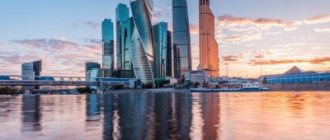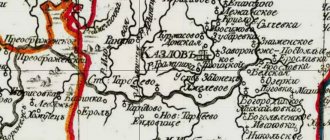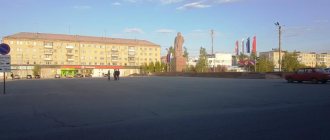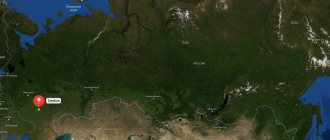Smolensk is one of the oldest Russian cities, the western outpost of Russia borders the Republic of Belarus, Tver, Bryansk, Kaluga, Moscow and Pskov regions. Since ancient times, its location determined the city’s importance in the defense of the country and the development of trade and cultural ties between peoples.
“From the Varangians to the Greeks”
It is believed that the city dates back to 863, but this is only the first dated mention - in the Ustyug list of the chronicle: the Novgorod boyars Askold and Dir were heading to Tsargorod along the Dnieper River, where they saw the settlement. “The city is great and there are many people...” - the chronicle reports. This means that the city is much older than its first “official” mention.
Smolensk connected the peoples of Scandinavia and the Black Sea region along the great trade route “From the Varangians to the Greeks.” This path ran not only along rivers and lakes, but also on land - the boats were dragged, often damaging the bottom. And in the ancient city they learned to tar boats and repair the clothes and shoes of travelers. This is where, according to the first Smolensk historian Nikifor Murzakevich, the name of the settlement came from: “Smolyans” - travelers nicknamed those who drove resin and traded in it. “Smolenets” - they called the settlement Smolyan.
A small digression from antiquity. The Smolyans (modern Vikings) were the first and only ones in the world to travel the entire ancient route from the Varangians to the Greeks. The expedition of the Smolensk club “Viking-Nevo” lasted a quarter of a century and ended in 2014. At certain stages of the expedition, Scandinavians - Swedes and Finns - joined the Smolensk people.
The expedition began on the boat "Dir", which today is installed at the entrance to the Naval Museum named after Admiral Nakhimov. The Askold boat is stored on the site of one of the first travelers. The Smolensk residents completed the expedition on an exact copy of an ancient boat, built with their own hands according to the drawings of a Swedish shipbuilder and traveler.
Let's continue the historical path. According to a number of serious researchers and historians, the ancient settlement was located lower along the Dnieper than the modern city, where archaeologists found the ancient Gnezdovo mounds during the construction of the Moscow-Warsaw railway in the mid-19th century. More than 4 thousand mounds, one and a half thousand preserved burials with jewelry, weapons, and household items - a truly unique archaeological discovery!
Excavations are still ongoing here with sensational finds. And the burial ground itself is the largest necropolis in eastern and northern Europe.
Smolensk War: the struggle of Vasily III for Western Rus'
In the autumn of 1512, Russian troops invaded Lithuania. The main army, together with the Grand Duke himself, marched on Smolensk. In the vanguard there were detachments of mobile local cavalry, in the rearguard there were infantry with handguns and a “detail”, a corps of siege artillery (probably about a hundred guns, including very large calibers).
Smolensk was a stronghold, well protected for that time. Covered by the Dnieper on one side and swamps on the other, the walls of the fortress were cut from thick oak logs and were filled with a mixture of stones and earth for greater strength. This “combined” protection ensured high resistance against cannonballs—Russian artillery was about to be tested. There was continuous bombardment of the fortress for a month and a half, but the areas destroyed during the day were repaired at night by the garrison and townspeople. Smolensk stood firm. Even the night attack, in which the corps of “squeakers” participated, was repulsed by the Lithuanians.
A noble Muscovite on a German engraving. Source: wikipedia.com
The Grand Duke and his army stood at the city walls until the beginning of spring. Sigismund, fortunately, did not interfere with the “Muscovites” in any way - the pace of mobilization in Lithuania was not comparable to its eastern neighbor. The collection of the “Pospolita Rusheniya” (noble militia) was late. By the beginning of March 1513, it became clear that the spring thaw was approaching, and the Smolensk people were ready to continue defending themselves. The army began to run out of fodder. Then Vasily III retreated from Smolensk, but only to return soon.
The city is a warrior, the city is a shield
In the 12th century, the Smolensk Principality experienced a magnificent flourishing, but became the prey of the warlike detachments of the Golden Horde. What kind of wars have not shaken the walls of the ancient fortress! As a result of the independence of the wealthy principality, it came to an end - for a whole century it became part of the Lithuanian state. A short return to the bosom of the Moscow Principality - and again foreigners rule in Smolensk: Smolensk passes to the Polish-Lithuanian Commonwealth.
Only in 1654, as a result of the Russian-Polish War, Smolensk finally became part of Russia. In 1812, bloody battles with Napoleon's troops took place under the walls of ancient Smolensk. From 1941 to 1943 the city was occupied by German troops and completely destroyed.
Philosopher, founder of Slavophilism, poet Alexey Stepanovich Khomyakov died
Discussion: 6 comments
- Volodislav:
10/06/2012 at 00:00Not from the Polish-Lithuanian Commonwealth, but from Poland. The word "Rzeczpospolita" means "republic". Their name today is exactly the same as it was then - Zheczpospolita Polska. Calling Poland “Rzeczpospolita” is incorrect.
- MVN:
10/06/2012 at 00:00
This was the official name of the then Polish-Lithuanian state, which is used in generally accepted historiography.
- Vladimir:
01.12.2015 at 00:00
the defense of Smolenka in 1618 is illustrated in a new cartoon, but still the picture shown there does not at all resemble the events occurring in reality https://kinonovinka.net/load/krepost_shhitom_i_mechom/1-1-0-246
- Vasya:
10/28/2016 at 00:00
Russians and Poles will never be reconciled……….
- Sergey:
07/10/2017 at 00:00
Oh, how notable local liberals were hung on the wall.
- Passersby:
04/19/2018 at 17:41
Smolensk is ethnically and now a Belarusian city, where the BSSR was proclaimed in 1918.
The city is a hard worker
Immediately after the liberation of the city, the restoration of industrial enterprises, transport, residential buildings and cultural sites began. The townspeople worked under the slogan “If you live in the Smolensk region, be a builder!” And they achieved their goal. Today Smolensk is one of the most beautiful cities in Central Russia, with unique monuments that tourists from all over the world come to see.
Smolensk is a large cultural center with five theaters, museums, unique estates of the famous philanthropist Princess Tenisheva, composer Mikhail Glinka, writer Alexander Griboyedov, with a modern cultural and exhibition center. For the city's anniversary (1150 years), new ice arenas and stadiums, sports and recreation centers were built.
The city annually hosts numerous international exhibitions and sales of goods.
Smolensk is a large industrial center with a population of 360 thousand inhabitants. Large enterprises of the military industrial complex operate here, related to the production of space and aviation equipment and weapons.
Smolensk is recognized as the capital of Russian diamonds. For more than half a century, the Smolensk cutters of the Kristall production association have been conquering the world diamond market. Talented jewelers work with them. The most striking result of their work was the creation of a replica of the Great Imperial Crown of the Russian Empire for the anniversary of the House of Romanov.
Smolyan residents were able to cut 11.5 thousand diamonds for this work of art, which began its triumphant march through museums in the capital and regions of Russia.
The oldest light industry enterprise in Russia, CJSC Smolensk Hosiery Factory, recognized as a leader in its industry, successfully operates in the regional center. Its products are exported to many European countries, including fashion trendsetter France.
Processing enterprises in the meat and dairy industries provide city residents with fresh products. At any time in Smolensk you can buy fresh village milk at street milk dispensers. They are installed in all microdistricts of the city.
Siege artillery is the key to cities
Among the Grand Duke's arguments in the fight against the fortress walls was the extensive artillery park created under Ivan III. Russian artillery was one of the most advanced in Europe, although the era of heavy artillery was just beginning - its great connoisseur was the Burgundian Duke Charles the Bold, after whose death his work was continued by Charles VII of France, who received part of the Burgundian arsenals at his disposal. During the king's campaign in Italy, the walls of medieval cities collapsed under a hail of French cannonballs, which gave impetus to the development of new ideas in fortification.
Cannonmaking was a strategic industry in the 16th century, comparable to modern nuclear forces, because only a powerful and independent state could afford the full cycle of production, maintenance and operation of heavy guns. The effect of bombards and mortars throwing 250-kilogram cannonballs was no less than that of explosions at the Bikini Atoll or the Semipalatinsk test site.
During the campaign of the Lithuanian prince Vitovt against Novgorod, one shot from a super-powerful bombard was enough to persuade not only the besieged fortress of Porkhov, but also Veliky Novgorod itself to negotiate. The Russians paid an impressive ransom of 11 thousand rubles and recognized Vytautas’ victory - and all at the cost of one shot. It is curious that for the mentioned gun the shot turned out to be fatal: the gun was torn apart along with its creator and servants. It is unlikely that the prince grieved greatly for the killed gunner, but he appreciated the effectiveness of the artillery.
On seven hills
Smolensk stretches along the Dnieper, in the upper reaches of which it is located for 25 kilometers (direction from east to west) and for 14 kilometers - from south to north. The Dnieper here is not as majestic as, for example, in Kyiv, where “a rare bird will fly to the middle...”. These are the sources of the great river. Although in the middle of the last century it was more abundant in water and river buses “ran” along it.
The current administration intends to revive navigation on the river. For this purpose, as the governor’s press service reports, a contract has been signed to clean the riverbed of sand, silt, and shells from the Great Patriotic War. It is assumed that the cleaning of the riverbed will be carried out by the Belarusian side, which is interested in supplying crushed granite stone for the construction of Smolensk roads. As you know, the cheapest transportation of goods by water is considered the cheapest today.
Belarusians will have to remove about 180 thousand tons of soil along seven and a half kilometers of the waterway. The project is being financed by the Federal Agency for Water Resources of the Russian Federation: the region will receive over 82 million rubles in the form of subventions.
It should be noted that in preparation for the anniversary of Smolensk, an embankment was built on the left bank of the Dnieper at a cost of over 600 million rubles. But it is almost always deserted: it offers a dull view of the right bank. From the embankment you can only see the chaotically located ridiculous shopping pavilions on Kolkhoz Square, disparagingly called “kolkhozka” by the local population. The legacy of the Soviet era has long required serious reconstruction, but so far the local authorities are limited to “patching holes”, without having a comprehensive project for redevelopment of the area.
Sights of Smolensk
The history of the city and its inhabitants have created a wonderful atmosphere that allows tourists of any age to visit Smolensk. The provincial charm, ancient traditions and unique culture of the city have been preserved, despite the rapid development of modern civilization. Yes, Smolensk is moving towards a new life with quick and confident steps, but city residents still remember the great past: ancient churches are being restored, interesting museums are being created, creative cafes are opening, and the central streets of the city and green park alleys offer strolls under their arches.
One of the main attractions of Smolensk is the Holy Assumption Cathedral, which is located on Cathedral Hill and can be seen from almost every part of the city. Having retained its shining golden domes, the beautiful cathedral is rightfully one of the majestic temples of our country. It houses the Smolensk Icon of the Mother of God Hodegetria.
An equally outstanding landmark is the Smolensk fortress wall. Its construction, as an important defensive structure, dates back to the late 16th and early 17th centuries. The length of the wall is 6.5 km and includes 38 towers, although only 18 of them have survived at present.
By decree of Tsar Vasily III, the Ascension Monastery was built in 1515. Initially, all the buildings of the monastery were made of wood, and later, by decree of Peter I, it acquired a new appearance of stone. But not only Orthodox churches were built on the territory of the city; one of these churches, the Church of the Immaculate Conception of the Blessed Virgin Mary, is a Catholic church that is now inactive. It was made in the neo-Gothic style in 1884-1896.
On the 100th anniversary of the fateful Battle of Borodino, it was decided to open the Alley of Heroes, on which on August 26, 1912, a bust of Colonel M.I. the Victorious was installed. Kutuzov, and on the occasion of the 175th anniversary, busts of P.I. Bagrationa, M.B. Barclay de Tolly. Also, during the Great Patriotic War, soldiers who died in battles were buried in the garden. Now on this site there is a memorial complex of WWII heroes.
Climate and ecology of Smolensk
Smolensk is located on the Central Russian Upland, hence the climate - continental with pronounced moderation under the influence of the Atlantic Ocean. In ordinary words, quite comfortable for living, without severe frosts or sweltering heat. Sometimes there are years when there are frosts below 30 degrees for several days, or the same heat with a plus sign. But this is an exception.
The average annual temperature is kept within 5 degrees: in winter about minus 10-14 degrees, average summer temperatures are within 20 degrees Celsius.
Local residents say that the climate in Smolensk is similar to London: high humidity, in some periods up to 98 percent, frequent rains, fogs. 160 days of cloudy and rainy days a year.
But there is no smog, like in the capital of Foggy Albion, in Smolensk. In post-Soviet times, the production of many types of products, the production of which had a negative impact on the environment, ceased. In particular, the production of fluorescent lamps has been completely stopped - mercury vapor has disappeared.
Smolensk still remains one of the greenest cities in Russia. A large number of parks and squares are located in the central part of the city. There are large green areas in all districts of the regional center. The total area of green spaces is one third of the city's territory (166.35 kilometers).
Geographical location of Smolensk
The city is very conveniently located on the upper banks of the Dnieper, southwest of the capital of our country: the distance from it is about 378 km. That is why Smolensk is one of the most remote administrative centers from Moscow, the regions of which directly border the capital region.
Residential buildings are located along the banks of small tributaries of the Dnieper and on high inter-river hills and ridges that form the so-called mountains. In some places the drops reach about 90 meters in height, so it is believed that Smolensk is a city that stands on seven hills.
According to the census held in 2010, the city’s population is 330 thousand 970 people and this corresponds to 54th place among Russian cities.
Administrative division of the city and demographic situation in Smolensk
According to Rosstat, 331 thousand people live in the territory of the regional center (data as of January 1, 2014). Most of them are women – 183 thousand. 79 thousand are people of retirement age, 208 thousand are the working population. Young people often leave Smolensk in search of work in Moscow and St. Petersburg.
Recently there has been a slight increase in the birth rate. As of January 1, 2014, 3,637 newborns were registered, which is 40 more babies than in the previous period.
The mortality rate is decreasing - by 152 people compared to 2013. However, the natural population decline of the city remains high – more than 700 people.
The situation on the labor market is relatively calm. According to the Smolensk City Employment Center, the unemployment rate at the end of 2014 was 0.64 percent. The labor market tension coefficient is 0.5. For every person who loses a job, there are two vacancies. Basically, these are blue-collar jobs with decent wages. The average monthly salary in Smolensk is 24 thousand rubles.
Smolyan residents live in three districts of the city - Leninsky (central district), Zadneprovsky and Promyshlenny (the largest district in terms of population and territory).
Set a goal and outline a plan
The goal of the work is simple - to get to know your hometown even better.
And the action plan is as follows:
1. Find information about the city on the Internet. 2. Select those “city” numbers and values that we will take with us into the project. 3. Come up with problems with selected numbers and quantities. 4. Design the project in the form of an interactive tablet.
This is the plan. Before getting started, a few words (sentences) about what the problems are doing here.
In the textbook on the page with the “Mathematical Handbook” project, the authors propose to hold a competition for the most interesting problem, compiled from the materials of the handbook.
So we decided to immediately invent problems.
Now you can get started.
Districts and real estate of the city of Smolensk
Zadneprovsky district
Native Smolensk residents habitually call the Zadneprovsky district Pokrovka, although today new (obviously residential) microdistricts Sitniki and Korolevka have already been built there - multi-storey panel buildings with the cheapest prices per square meter in the city (on average 40 thousand rubles). Smolensk residents are being relocated to these microdistricts from dilapidated housing located in the city center. In residential areas there are few shopping and entertainment centers and tourist sites. Until some time, it was difficult to get to objects in the Industrial District - it was necessary to change trains in the city center. In the anniversary year for Smolensk, local authorities corrected this situation and replaced the old tram tracks that connect the Sitniki microdistrict with the Industrial District.
In the Zadneprovsky district there are large factories: aviation, auto aggregates, and the production of complex road machines (harvesting equipment). The infamous Severny airfield is also located here, in the sky above which the tragedy with Polish Air Force No. 1 occurred.
Leninsky district
The most attractive and expensive area for living is Leninsky. All cultural objects and attractions, higher and secondary educational institutions, prestigious schools and gymnasiums are concentrated here. The cost per square meter starts from 50 thousand rubles and up to 100-120 thousand, depending on the quality of housing and its distance from the center.
In addition to the historical center, the Leninsky district includes the Klovka and Chernyakhovka microdistricts. In the first, densely populated area, which is difficult to reach from the center on foot, almost all infrastructure is missing. Accordingly, the cost of housing is one of the lowest: a one-room apartment can be bought for 1.2 million rubles.
The Chernyakhovka area is considered an elite place to live - nearby are the huge Readovka forest park with a lake and a modern sports and fitness complex, the building of the Smolensk branch of the Moscow Power Engineering Institute. Recently, the construction of luxury houses overlooking the forest park has begun here. The cost per square meter of housing ranges from 45 to 60 thousand rubles.
In the Vishenki area (the south-eastern entrance to the city) construction of the New Smolensk microdistrict has begun. The cost per square meter in a new building is from 30 thousand rubles. The new microdistrict is attractive because along with the construction of housing there is the construction of clinics, schools, kindergartens, and entertainment centers. In the future, the city will develop in this direction at the expense of the lands of the Smolensk region. A comprehensive development of 800 hectares is planned. So far they cannot find a single developer for this tidbit - such large volumes are “too tough” for Smolensk builders.
Industrial area
The largest industrial district in terms of territory was previously limited to two microdistricts - Popovka and Kiselevka. In the last decade, active construction has been underway here. A new microdistrict of low-rise buildings, “Nightingale Grove,” has grown up, surrounded by a tree nursery with a lake. Now the microdistrict is developing in the southern direction of the dacha zone through the construction of individual cottages.
The Yuzhny microdistrict, previously considered unprestigious and unpromising, is becoming popular. Recently, about 100 thousand square meters of housing with individual heating have been commissioned here. New residents are attracted by the transport accessibility of the microdistrict - the city center can be reached in 10 - 15 minutes.
Mass development has begun in the west of the district - a multi-storey district “Kiselevka Village” is being built. In mid-2014, a square meter of housing under construction cost only 28 thousand rubles. Of course, the construction of a full-fledged infrastructure in this microdistrict is still a long way off, but people are attracted by the affordable price of new housing and the prospects of the microdistrict.
Where to take pictures
I don’t know about you, but I don’t rely too much on my memories. And I plan to enjoy photographs and souvenirs in retirement. So this excursion worried me more from the point of view of a photo shoot than pure impressions.
Temples and museums
This has already been discussed, so just a few words. The city is beautiful, photographs against the backdrop of churches and individual buildings will most accurately describe Smolensk in your memory.
Destroyed bridge across the Dnieper. It’s a pity that the weather did not allow us to safely descend closer. Well, the streets, they seemed to me in the style of the historical center of St. Petersburg.
Fortress wall
It goes in parts throughout the entire historical center. The area along the river is now in the forests, but further on you can take many beautiful photographs. Don't forget the towers and museums.
Lenin Street
Pedestrian street of the city, analogous to Arbat. In winter it's desolate, but in summer it's worth a walk. At least to come to the parks, where the best places for photo sessions are.
Blognier Garden
Now it’s a rather boring little park, but it has an interesting history. If you find the park uninteresting, sit on a bench and open Wikipedia. And we're talking about the photo.
There is a fountain, and in the summer there are many exhibitions and advertising compositions in the park.
Deer:
By the way, the deer is made of bronze, and appeared in the garden in 1946, it was taken from the dacha of Kaiser Wilhelm II as a military trophy.
Lions. They are also a war trophy of the Second World War.
Did you find anything else?
Transport
Smolensk is one of those Russian cities where there are trams.
They connect all areas of the city with each other with access to the railway and bus stations. In preparation for the city's anniversary, 15 new comfortable carriages were purchased. The rails have been replaced using modern technologies. Some routes are served by trolleybuses. The main mode of transport in the city remains minibuses, which serve more than 30 routes.
The price of travel on public transport is 14 rubles, both for municipal and private carriers.
Traffic jams, in the provincial sense, occur during peak hours. Basically, they arise due to parking of cars on the roadway - the city has a catastrophic lack of parking lots and parking spaces for vehicles. At night, all courtyard areas turn into parking lots. Despite this, car theft or arson is a rare occurrence in Smolensk.
Due to the compact location of the city, you can easily get from one part to another on foot. In half an hour you can get from Kiselevka to the city center without resorting to motor transport.
The city has developed taxi services. More than 3 thousand cars per shift operate on the market for these services.
The Grand Duchy of Lithuania: to whom the Horde, and to whom the mother is dear
Batya's invasion became a death sentence for Kievan Rus. The fragmented principalities in the east fell under the yoke of the Horde. The Western principalities were included in more powerful and consolidated entities - Lithuania and Poland.
Seversky and Verkhovsky (located in the upper reaches of the Dnieper) lands, Smolensk, Kyiv, Podolia, Volyn - all of them became part of the Grand Duchy of Lithuania, which spread within the borders of modern Lithuania, Belarus and most of Ukraine. For the inhabitants of these lands, the Lithuanian princes were the ones who saved them from the yoke and feudal tyranny.
Grand Dukes Vasily III and Sigismund the Old. Source: wikipedia.com
The annexation of the Russian principalities significantly strengthened Lithuania - by the middle of the 15th century, the area of the grand duchy was almost 1 million square meters. km. The overwhelming majority of this territory was inhabited by a Russian Orthodox population. The conclusion of a personal union between Poland and Lithuania, the gradual strengthening of Polish and Catholic influence in the lands subject to Vilna changed the situation in the country, where the majority of the population, who professed Orthodoxy, slowly but surely began to have their rights infringed.
From liberators from the Horde yoke, the Lithuanian princes began to turn into tramplers of faith. At the same time, in the east, the process of uniting the fragmented principalities into a single Russian state began. The Lithuanian princes well understood how dangerous their neighbor in the east was and sought to prevent the formation of the Eastern Russian principality, because Lithuania itself claimed the right to become the center of the unification of the lands of Kievan Rus.
Budget and investments
According to the press service of the Smolensk City Council, the budget for 2015, as in previous years, will be deficit. Its income is 10 percent less than expenses and amounts to a little more than 5 billion rubles. At the same time, the government debt of the municipality is growing - it exceeds 3 billion rubles. Despite this, the city authorities manage to maintain the entire block of social guarantees and benefits for the population. In the city, teachers and ambulance workers are paid local bonuses.
Despite its favorable geographical location, the region has not become attractive to investors. The volume of investment in fixed capital is one of the last in the Central Federal District. In 2013, investors allocated 5.5 billion rubles to the region, and for 9 months of 2014 - 3.25 billion. The situation with investment policy in the Central Federal District is worse only in the Ivanovo, Kostroma and Oryol regions.
Vasily III - successor to his father's work
The son of Ivan the Great, Vasily III, continued the policy of collecting Russian lands. The first war with Lithuania in 1507-1508 was just a warm-up - neither side was happy with the situation, so a new conflict was a matter of time. A reason for war was soon found: Elena Ioannovna, the daughter of Ivan III, the sister of Vasily III and the widow of the recently deceased Grand Duke of Lithuania and King Alexander of Poland, died in Lithuania under mysterious circumstances. After the death of her father and husband, the position of the princess, who was the pillar of Russian influence in Lithuania, became barely bearable. It got to the point that one day supporters of Poland and the Pope at the Vilna court dragged Elena out of the church and arrested her right during the service. Soon, the daughter of Ivan the Great died in captivity under strange circumstances, which could be considered a direct challenge to Vasily III.
The matter was aggravated by the fact that Russian intelligence intercepted letters from the Lithuanian prince Sigismund (brother of that same Alexander, Elena Ioannovna’s husband) to Crimea, in which he tried to persuade the khan to war with Moscow. Now, no assurances from the Lithuanians about peaceful intentions were taken seriously - in 1512, without waiting for the creation of an anti-Moscow coalition, Vasily declared war on Sigismund.
The geographical position of Smolensk, which in 1512, 1812, and 1941 had important strategic importance as a stronghold on the way to Moscow, made it the primary goal of the war that began. Russian troops had already approached the city during the war of 1500–1503, but were unable to cope with the powerful stronghold - the lack of heavy artillery excluded the possibility of an assault, and the harsh winter gave no hope of starving out the city. Now Moscow has decided to take revenge.
Healthcare
The level of medical care provided to the population is quite decent. Smolensk has its own medical academy, a well-equipped regional clinical hospital, cardiovascular and diabetes centers. The Federal Center for Orthopedics and Endoprosthetics began its work. A network of private medical centers has been developed.
According to information from the Smolensk Regional Department of Health, the region has seen a decrease in the incidence of the cardiovascular system and infant mortality.
Eastern section of the Smolensk fortress wall
Almost every tourist visiting Smolensk wants to climb the walls of the Smolensk “Kremlin” in order to better feel the spirit of this powerful fortification. Alas, in Smolensk, unlike Novgorod or Pskov, you will not find neat steps leading to the fortress and fences at the edge of the walls. If you still want to go up, we recommend doing it on the Eastern section of the Smolensk fortress wall, in the area of Timiryazev Street.
From the top of this section there is a beautiful view of the Assumption Cathedral, as well as amazing panoramas of the fortress wall itself.
Monuments of Smolensk that are worth seeing
These historical monuments of Smolensk are especially popular among tourists:
- Resurrection Hill. This is the highest point in the city, although some mistakenly consider Cathedral Hill to be the highest point. Resurrection Hill is 7 m higher than it. On the hill stands the Resurrection Church. She's pretty small. For some time, the church housed a planetarium, but in 2012 it was moved to a building on Voikova Street, which is very nearby.
- Monument to A. T. Tvardovsky and Vasily Terkin. This landmark of Smolensk is located on Victory Square. The monument is quite colorful. The townspeople like to relax on the benches next to it.
- Monument "Scorched Flower". Erected in 2005 in memory of the children who were imprisoned in concentration camps during the war. All these terrible places are listed on the monument. Frost goes down your skin when you stand near him and are mentally transported to wartime with all its horrors.
- Foucault pendulum, located in the planetarium on Voikova Street. The Foucault pendulum demonstrates the daily rotation of the Earth and shoots up 12 m.
Square of Memory of Heroes
Throughout history, many places have appeared in the city of Smolensk where residents could express their gratitude and respect to people who gave their lives for the peace and well-being of their fellow villagers. One of these places is the square near the Donets Tower, on the territory of which the heroes are buried. Among them is the legendary Mikhail Egorov, who, together with Kantaria, planted the Soviet flag over the Reichstag.
The Eternal Flame of Glory, busts of great commanders and a monument to the heroes of the war of 1812, which is called the “Monument with Eagles,” are also located there. It represents a nest guarded by two eagles. It looks symbolic and conveys the spirit of the Russian people.
Significant dates in the history of Smolensk
- 863 - first mention in chronicles.
- 882 – annexation to Kievan Rus.
- 1127 – birth of the Smolensk Principality.
- 1239 – invasion of the Mongol-Tatars. During the battles, the city was completely destroyed for the first time.
- 1514 – liberation of the city from the power of the Lithuanians.
- 1595–1602 - construction of the Smolensk fortress.
- 1654 – liberation from the oppression of the Polish-Lithuanian Commonwealth.
- 1706 – Peter the Great visited the city and assigned the status of a province.
- 1890 – opening of the first water pipeline.
- 1901 - the appearance of electricity in the city.
- 1943 – liberation from the fascist invaders.
- 1966 - the city was awarded the Order of the Patriotic War, first degree.
- 1983 – Smolensk was awarded the Order of Lenin.
- 1985 – Smolensk was awarded the title “Hero City”.
- 1973 – opening of CHPP-2.











